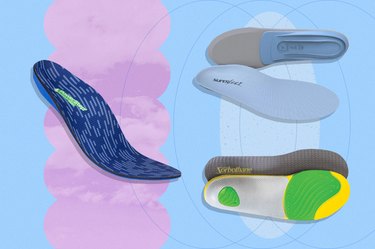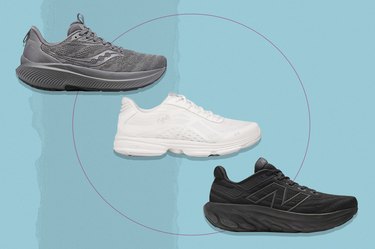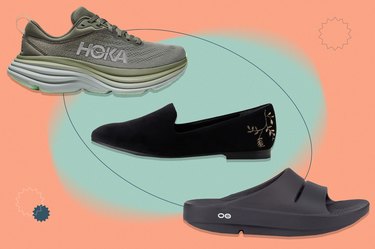
Some people are born with naturally wider or bigger feet. But if you've noticed that your feet have recently become fatter or swollen, certain underlying health conditions may be to blame. Fortunately, knowing how to get rid of fat feet may help ease your discomfort.
You may carry more fat in your feet if you have overweight or obesity, according to the National Health Service (NHS). Other times, the following health conditions may lead to fat, swollen feet, per Harvard Health Publishing:
Video of the Day
Video of the Day
- Aging, which can weaken the valves in your veins and allow blood to pool in your feet
- Inflammation in your veins
- Blood clots in your legs
- Heart failure, which can cause poor circulation and allow blood to pool in your feet
- Fluid buildup from liver or kidney disease
- Bone or tendon injuries that lead to a fat foot or a foot and ankle injury, such as a sprain
Pregnancy is another common cause of fat feet: Hormonal changes, fluid retention and added pressure on your veins from a growing baby can all contribute to foot and ankle swelling, according to the Mayo Clinic.
How you lose weight in your feet ultimately depends on the cause of your fat or swollen feet. But here are seven potential ways to address it.
If you're not sure about the cause of suddenly swollen feet, visit your doctor to check for an underlying condition or injury so you can address the problem and get your foot swelling (and any other symptoms) under control.
Go to the hospital immediately if you have shortness of breath, are coughing up blood or have a tight, heavy feeling in your chest, since these symptoms may be due to a blood clot in your lungs, according to the NHS.
1. Eat a Balanced Diet
Your diet may help you get rid of fat or swollen feet. Here are some things to consider when it comes to your meals:
Diet for Weight Loss
Wondering how to lose weight from your feet specifically? Though it's not possible to target weight loss in your feet (or in any one body part, for that matter), losing weight throughout your body if you have overweight or obesity may help you lose feet fat, too.
And a balanced diet is a crucial component of any weight-loss endeavor, per the Mayo Clinic. Eat meals filled with the following foods:
- Fiber-rich fruits and vegetables
- Whole grains like whole-wheat bread, oatmeal and brown rice
- Sources of protein, including nuts, eggs, fish and lean meat like chicken
- Beneficial fats, including those found in nuts, olive oil, avocado and dairy products like yogurt
At the same time, limit or avoid certain foods, including:
- Refined carbohydrates like white bread and cereal
- Foods with added sugars like baked goods and soda
- Foods with trans or saturated fats like red meat, butter and some cheeses
In addition to eating nutritious foods, you'll also need create a daily calorie deficit, per the Mayo Clinic. Cut your intake by 500 to 1,000 calories a day to lose weight at the safe and sustainable pace of about 1 to 2 pounds per week.
Warning
Eating too few calories can deprive you of essential nutrients, so your calorie intake should not fall below 1,200 per day for people assigned female at birth or 1,500 per day for people assigned male at birth (except under your doctor's supervision), per Harvard Health Publishing.
Limit Salty Foods
No matter your weight, eating too much salt can also trigger foot swelling, according to the NHS. Accordingly, cut back on high-sodium foods such as:
- Table salt
- Sauces like teriyaki and soy sauce
- Canned vegetables and beans
- Processed meats like salami and sausage
- Smoked or dried meats and fish like jerky
- Salted nuts
- Frozen pizza
- Chips
Get Enough Magnesium
Swollen feet can also be a symptom of a magnesium deficiency, according to the Cleveland Clinic. To help, munch on magnesium-rich foods like:
- Spinach
- Nuts and seeds
- Beans
- Quinoa
- Brown rice
- Lentils
- Avocados
- Dark chocolate
2. Exercise Regularly
Exercise is also important when it comes to losing weight. Adults should do 150 minutes of moderate aerobic activity or 75 minutes of intense cardio along with at least two strength training sessions per week, according to the Physical Activity Guidelines for Americans.
How do you lose weight in your feet — and throughout your body — from exercise? Well, regular activity contributes to your daily caloric deficit.
And weight loss aside, moving your body can also help prevent or relieve foot and ankle swelling by keeping your blood flowing and flushing away built-up fluids, according to Mount Sinai.
If you're not sure where to start, try cardio activities like:
- Walking
- Running
- Cycling
- Swimming
- Rowing
- Dancing
- Boxing
You can also do different types of strength training, such as:
Tip
Foot and ankle exercises may help reduce swelling from fluid buildup. But remember — exercising your feet won't directly make them lose fat, because you can't target weight loss in a single body part, per ACE.
3. Stay Hydrated
Drinking plenty of water may support weight loss by helping your body function at its best, fueling you during exercise and suppressing your appetite, according to Johns Hopkins University.
It can also help prevent or ease fat feet from fluid retention, according to the Cleveland Clinic.
Sometimes an underlying condition can lead to fluid buildup, but other times, it happens naturally as your body starts to run low on hydration. Drinking enough water can help keep your fluid balance in check and flush waste from your body, all of which can prevent water retention and the swelling that can come with it, per the Cleveland Clinic.
How Much Water Should You Drink?
Use the following calculation to determine how much water you should drink a day:
- Body weight (in pounds) ÷ 2 = minimum ounces of water you should drink per day
4. Wear Comfortable Footwear
If you're having trouble or discomfort fitting wide or fat feet in shoes, it may be wise to reconsider your footwear choices. First, make sure you're wearing shoes that are the right size, as restrictive footwear can cut off your circulation and contribute to swelling, according to the Cleveland Clinic.
If you are wearing the right size, make sure to wear shoes that are comfortable for fat, swollen feet. Here are some things to look for when picking out your footwear, according to the University of Michigan:
- Solid arch support
- A stiff heel for ankle support
- Proper width for your feet
5. Try Compression Socks
Shoes aren't the only important piece of footwear when it comes to relieving swollen feet — socks may also help.
Compression socks gently squeeze your feet, ankles and legs to enhance your circulation and prevent the fluid buildup that can lead to swelling, according to the Cleveland Clinic. You can wear them while exercising or at rest to reap these benefits at any time of day.
6. Elevate Your Feet
Relieve swollen feet by elevating them above your heart, according to the Cleveland Clinic. That way gravity can take effect and drain excess fluid from your legs to relieve any swelling.
Lying down and propping your legs on a pillow or lying on the ground with your legs up the wall can both help.
7. Take an Epsom Salt Bath
Soaking swollen feet in a bath full of Epsom salts may also help relieve swelling, according to the Cleveland Clinic. This could have to do with Epsom salts' magnesium content, which may have the ability to relax your muscles and reduce inflammation, per the Cleveland Clinic.
To get started, draw yourself a bath and dissolve 300 grams of Epsom salt in the water. Then just sit back, relax and soak for at least 15 minutes, according to the Cleveland Clinic.
Warning
Epsom salt isn't like table salt — it's for external use only, per the Cleveland Clinic, so don't eat or drink it.
- University of Michigan: "Choosing the Right Shoes for You"
- Harvard Health Publishing: "What’s causing those swollen feet?"
- Mayo Clinic: "What causes ankle swelling during pregnancy — and what can I do about it?"
- National Health Service: "Swollen ankles, feet and legs (oedema)"
- American Council on Exercise: "Myths and Misconceptions: Spot Reduction and Feeling the Burn"
- Mayo Clinic: "Counting calories: Get back to weight-loss basics"
- Harvard Health Publishing: "Calorie counting made easy"
- Cleveland Clinic: "Swollen Feet and Ankles: Treatments to Try"
- U.S. Department of Health and Human Services: "Physical Activity Guidelines for Americans, 2nd Edition"
- Mount Sinai: "Foot, leg, and ankle swelling"
- Cleveland Clinic: "7 Things You Probably Didn’t Know About Epsom Salt"
- Johns Hopkins University: "Yes, drinking more water may help you lose weight"
- Mayo Clinic: "Mayo Clinic Healthy Weight Pyramid"
- Livestrong: MyPlate
- MyFitnessPal



